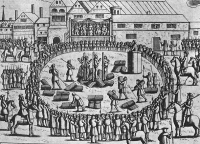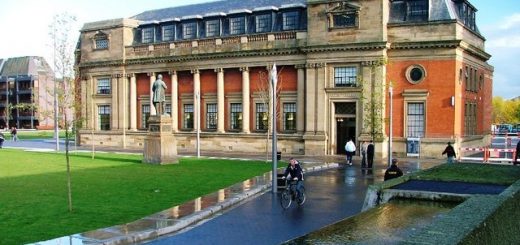Whitby Abbey
Whitby Abbey is one of the most atmospheric locations in England. The desolate ruins stand stark above steep cliffs overlooking the old whaling village of Whitby in North Yorkshire, a testament to the town’s former religious significance.
 The abbey was founded in 651AD, and was the site of the Synod of Whitby in 664, when a vote was held to decide if the church should adopt the Celtic or Roman date for Easter. The vote favoured the Roman date and this led to a decline in Celtic Christianity. The abbey’s influence decreased in the 9th century, and it was destroyed and looted in the bloody Viking raid of 867AD. In the late 11th Century a Norman knight came to Whitby and was inspired to rebuild the abbey, which continued as a place of monastic life until the dissolution of the monasteries by Henry VIII. Tradition holds that Henry’s men had the abbey bells loaded onto a ship, which sank – in heavenly retribution – not long after it had left the shore. In bygone years young lovers would listen for the sound of the bells in the depths, as this was thought to be a fortunate omen for their future.
The abbey was founded in 651AD, and was the site of the Synod of Whitby in 664, when a vote was held to decide if the church should adopt the Celtic or Roman date for Easter. The vote favoured the Roman date and this led to a decline in Celtic Christianity. The abbey’s influence decreased in the 9th century, and it was destroyed and looted in the bloody Viking raid of 867AD. In the late 11th Century a Norman knight came to Whitby and was inspired to rebuild the abbey, which continued as a place of monastic life until the dissolution of the monasteries by Henry VIII. Tradition holds that Henry’s men had the abbey bells loaded onto a ship, which sank – in heavenly retribution – not long after it had left the shore. In bygone years young lovers would listen for the sound of the bells in the depths, as this was thought to be a fortunate omen for their future.
 Whitby itself is steeped in folklore and legend, which, along with the abbey’s foreboding ruins are said to have provided inspiration for Bram Stoker’s gothic masterpiece Dracula. In the book Whitby is the destination for the doomed ship Demeter, which carries Dracula to England.
Whitby itself is steeped in folklore and legend, which, along with the abbey’s foreboding ruins are said to have provided inspiration for Bram Stoker’s gothic masterpiece Dracula. In the book Whitby is the destination for the doomed ship Demeter, which carries Dracula to England.
The first Abbess of the abbey, St Hild, became a focus for folklore and legend through the centuries and was said to have performed many miraculous deeds. Tradition tells how she rid the town of snakes, lopping off their heads with her enchanted whip. Fossil ammonites, frequently found on the shore, were once seen as the headless remains of these petrified snakes.
The abbess Hild was also once thought to make an appearance. Crowds from far and wide used to gather at the west side of Whitby Churchyard, between 10.00 and 11.00 in the morning, where there was clear view of the north side of the abbey and the highest window. When the sun shone on the window it created an illusion of a woman’s form wrapped in a shroud. This optical illusion was presumed to be the ghost of abbey’s founder, tradition grew that she also walked the abbey as a phantom.
 Other Whitby traditions include: a phantom coach and horses, which thunders to a halt outside the church, a headless spectre at Fitzsimmon’s steps, and a mischievous sprite called Hob (which is a generic name for a mischievous goblin), who haunts the dark country lanes around the town, and associations with the giant Wade who lived nearby. The first poet of England is also lived at Whitby in the 7th Century. He was given the gift of poetry after having an angelic vision.
Other Whitby traditions include: a phantom coach and horses, which thunders to a halt outside the church, a headless spectre at Fitzsimmon’s steps, and a mischievous sprite called Hob (which is a generic name for a mischievous goblin), who haunts the dark country lanes around the town, and associations with the giant Wade who lived nearby. The first poet of England is also lived at Whitby in the 7th Century. He was given the gift of poetry after having an angelic vision.
An ancient festival called ‘The Planting of the Penny Hedge’ is held on the shore here on the eve of Ascension Day. Wooden stakes are cut from Eskdale side and carried through the town at sunrise to the shore, where they are woven into a strong hedge before the tide turns. The name Penny Hedge is thought to relate the price of the knife used for cutting the hedge. In legend the ceremony dates back to 1159 when the Abbott of Whitby imposed a penance on three hunters and their future generations for murdering a hermit. To save them from execution they had to make a stake hedge that would resist the sea every year until their descendant had died out. The festival is probably related to the renewing of old boundaries around the parish.
 Whitby is an inspirational place to visit if you are interested in the folklore and traditions of Britain. The abbey has an archaeological display and gift shop open most of the year.
Whitby is an inspirational place to visit if you are interested in the folklore and traditions of Britain. The abbey has an archaeological display and gift shop open most of the year.
Directions: Whitby reached via the A171 from Scarborough or Middlesborough, or the A174 coastal road.




Re: Whitby Abbey
a really nice place even the steep walk up but lush all the same
Re: Whitby Abbey
Another absolute must to visit. Whitby in a storm is exhilerating; it is easy to see how Bram Stoker got his inspiration for the novel ‘Dracula’, with the abbey silhoutted against a darkened sky, the shipwreck that occured when Stoker was staying there,the whale’s jawbone, the vast cemetery… A small fishing town on the Northern coast with winding roads up steep inclines.Of late, ‘Dracula Experience’ type places have somewhat marred its quaint beauty but nevertheless another crucial Northern place to visit ,absorb the atmosphere and learn about the fascinating St.Hild(e)…
Re: Whitby Abbey
Haunted Churches’ (1939), Elliott O’Donnell (27 February 1872 – 8 May 1965)
Whitby Abbey is popularly believed to be haunted, at times, by a variety of ghostly phenomena, among them a figure supposed to be the phantom of the Lady Hilda. She, or rather it, appears in daylight, normally between 10 a.m. and noon, during the summer season, and has, I am told, been photographed, the photograph depicting a shadowy face peering out of a window.
A treasure is rumoured to be buried in the Abbey and, from time to time, attempts, usually clandestine, have been made to locate it. On one occasion, so the story goes, a Nonconformist minister and his daughter, armed with spades, stole into the abbey one moonlight summer night and, separating, commenced digging in what they thought were likely spots. They had been thus engaged perhaps an hour or so, when a hand tapped the daughter lightly on the shoulder.
" Yes, Pa," she said, " what is it ? " There was no reply, only another tap.
"Stop it, Pa," she exclaimed irritably. " Don’t be so silly. Why can’t you speak ! " Still no response but another tap. She looked round angrily and saw, not her father, but a tall figure in white, with no head, whereupon she fainted.
On another occasion, a man and a boy were passing near the abbey, early one morning, on their way to work, when they heard the sound of wheels in their rear.
They moved to the side of the road and a great hearse-like coach-and-four tore past them, driver and horses lacking heads. In terrified silence they watched it disappear in the direction of the abbey.
There is also a bell tradition in connection with the abbey. 1 When the abbey was suppressed in 1539, its bells were sold and put on board a ship, to be taken to London. The vessel had not, however, got out of sight of shore, before, from some mysterious cause, it sank. Fishermen sailing near the spot some days later were astounded to hear the chiming of bells proceeding from the sea-bed, and, periodically, ever since they have continued to send forth their ghostly music.
Up from the heart of the ocean
The mellow music peals.
Where the sunlight makes its golden path,
And the seamew flits and wheels.
For many a chequered century Untired by flying time, The bells no human fingers touch Have rung their hidden chime.